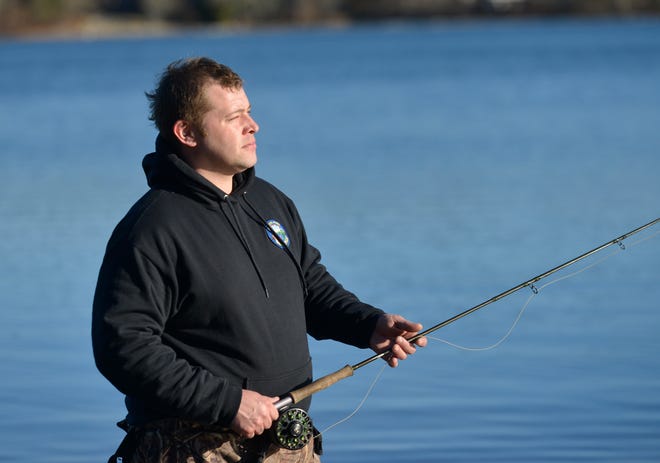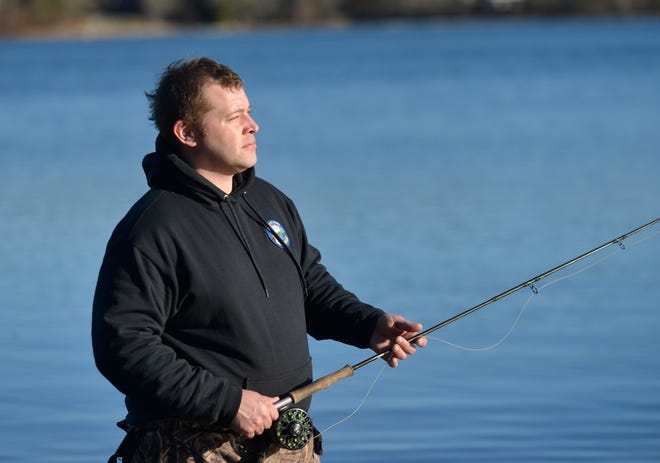Wampanoag members fight to keep winter fishing traditions alive
March 4, 2021

By Jessica Hill
Cape Cod Times
Carrying his fishing rod and gear, Dan Hannigan recently walked to Spectacle Pond in Wareham, where he chiseled a hole in the ice with a hatchet to drop a lure into the water. With the relatively warm weather this season, the ice is thin, less than the 4 inches needed to walk on it.
Standing by the side of the pond, he set a trap with a spring mechanism. When a fish bites, a flag will rise to alert him.
And so he waited.

Hannigan, a member of the Herring Pond Wampanoag Tribe, is among several Wampanoag people in the area who fish year-round in Wareham, on Cape Cod and in Plymouth to keep their cultural practices alive, even though the practice has been forced to change over the years.
“I couldn’t fish the way my ancestors used to,” he said.
Traditionally, tribes in the region have had a diverse number of species to fish, hunt and trap. Especially during the winter, when there are fewer crops to harvest, tribes would rely on different animals to feed their villages. They would catch lots of quahogs, oysters and bay scallops, Hannigan said, as well as perch, trout, salmon and pike. They set up eel pots in fresh and saltwater, a practice especially popular during the winter months.https://8b3ba1ee301d7fcc9eb68a2d69d12927.safeframe.googlesyndication.com/safeframe/1-0-37/html/container.html
Fishing, hunting for thousands of years
All over Cape Cod and central Massachusetts, archaeologists have found Wampanoag artifacts dating back thousands of years that reveal how tribal members fished, said Marcus Hendricks, a member of the Mashpee and Nipmuck Wampanoag Tribe as well as the Pequot Tribe.
Hendricks, who studied archaeology and worked as a cultural resource monitor for the Mashpee Wampanoag Tribe’s historical preservation department, has been on archaeological dig sites where stone weights once attached to fishing nets used for ice fishing were found.https://8b3ba1ee301d7fcc9eb68a2d69d12927.safeframe.googlesyndication.com/safeframe/1-0-37/html/container.html
“It is definitely a craft that had to have been passed down traditionally and culturally,” he said.
More:Tribal members harassed for practicing aboriginal fishing rights
Across the region, fishing weirs that were set up by indigenous people have been found. Weirs — obstructions placed either wholly or partially across a river to trap fish — were a popular method of harvesting, Hendricks said. https://8b3ba1ee301d7fcc9eb68a2d69d12927.safeframe.googlesyndication.com/safeframe/1-0-37/html/container.html
Members would take only what they would eat from the weirs, leaving the rest of the fish alive, Hannigan said.
To catch eels in the winter, tribes would use 10-foot spears that would go through the ice, Hendricks said. They would drill a hole through the ice and spear the eels, which during the winter would gather in a bundle underneath the ice to conserve energy.
Picking up lobsters on the beach
But overfishing, pollution and warming waters have caused these methods to change. Hendricks blames these issues on colonialism and capitalism.
“Hundreds of years ago, you could walk down the beach and pick up lobsters and put them in your basket, just lobsters that are walking around on the shore,” Hannigan said.

Hannigan remembers his father telling him stories of sitting down at the marina in Sandwich and catching cod, but that does not happen anymore.
“I have never been able to catch cod on the shores of Cape Cod myself, and I fish every day,” said Cheenulka Pocknett, a member of the Mashpee Wampanoag Tribe who fishes for a living. In order to catch cod, Pocknett said he has to steer his boat 16 miles offshore.
Pocknett said there is no longer ice on the bays, so he can no longer go eeling. He instead uses minnow and fish traps to catch eel, but he said his connection to the land is lost in that process.
In the past, members would give thanks through dance and song to the different animals that fed them, Pocknett said.https://8b3ba1ee301d7fcc9eb68a2d69d12927.safeframe.googlesyndication.com/safeframe/1-0-37/html/container.html
More:What you learned about the ‘first Thanksgiving’ isn’t true. Here’s the real story
“The action of going onto the ice and cutting into it and doing those motions to harvest those eels, that’s where a lot of our dances and our songs come from,” he said.
Now, when members ice fish, they use modern tools such as chain saws and steel axes to break through.
“Those traditions are being lost slowly,” Pocknett said.
Harvesting a wild oyster out of the bays is no longer done, Pocknett said, as the numbers have depleted significantly. The herring numbers are just starting to come back after a 15-year harvesting moratorium.
Pocknett estimates that about 20 tribal members still fish for a living.
“Twenty years ago … every family did it,” he said. “We had shuck houses where everybody would get together and shuck the shellfish and cook food. It would be a big community ordeal. That’s another thing that we lost. We don’t have the same numbers.”
Some work seasonally and will pick up fishing for a portion of the year, he said. Pocknett, however, fishes full time, working eight to 10 hours a day. He still barters with other community members, selling or trading his fish, similar to how tribal fishermen once operated.
Members used to fish on a much larger scale to feed their village, but only a few families still fish as a food resource. Hendricks fishes throughout the winter, but it does not sustain his family and him. Instead, he said he fishes more to keep his traditions alive.https://8b3ba1ee301d7fcc9eb68a2d69d12927.safeframe.googlesyndication.com/safeframe/1-0-37/html/container.html
“I could go to a place that has a lot of water and a lot of ice, but you’re spending a couple hours, if not half a day, to fill just one bucket,” he said. “It’s just not sustainable.”
“It’s still a good Ingenious activity in practice,” Hendricks said, “but not enough to sustain throughout the winter.”
Aboriginal fishing access rights
Access to bodies of water has also been an issue. While tribal members have the right to go through people’s yards to get to a body of water for fishing, many property owners build docks, stone walls and fences that limit access, and parking can be a challenge, Hendricks said. He has to ask permission of the property owner to park in their driveway or have someone drop him off.
Pocknett said he often gets harassed by people who are not tribe members and are unaware of his aboriginal fishing rights. He wears a body camera every day to provide proof should an incident occur.
Hannigan said he would love to teach his kids how to create a fishing weir, but the practice has proven bothersome for others. He said if someone sees him building a rock structure in the river, they tend to “freak out.”
“They don’t understand that you’re trying to teach your kids something” from hundreds of years ago, he said.
Hannigan likes to imagine what the Cape would have looked like 200 or 300 years ago, when there was less deforestation, cleaner waters and more fish. https://8b3ba1ee301d7fcc9eb68a2d69d12927.safeframe.googlesyndication.com/safeframe/1-0-37/html/container.html
“I just want to bring light to people to remember that the resources that we have have been depleted for the greed of men and for money,” Hannigan said. “If we take a second to remember how beautiful Mother Nature is, we might treat it differently.”
Contact Jessica Hill at jhill@capecodonline.com. Follow her on Twitter: @jess_hillyeah.